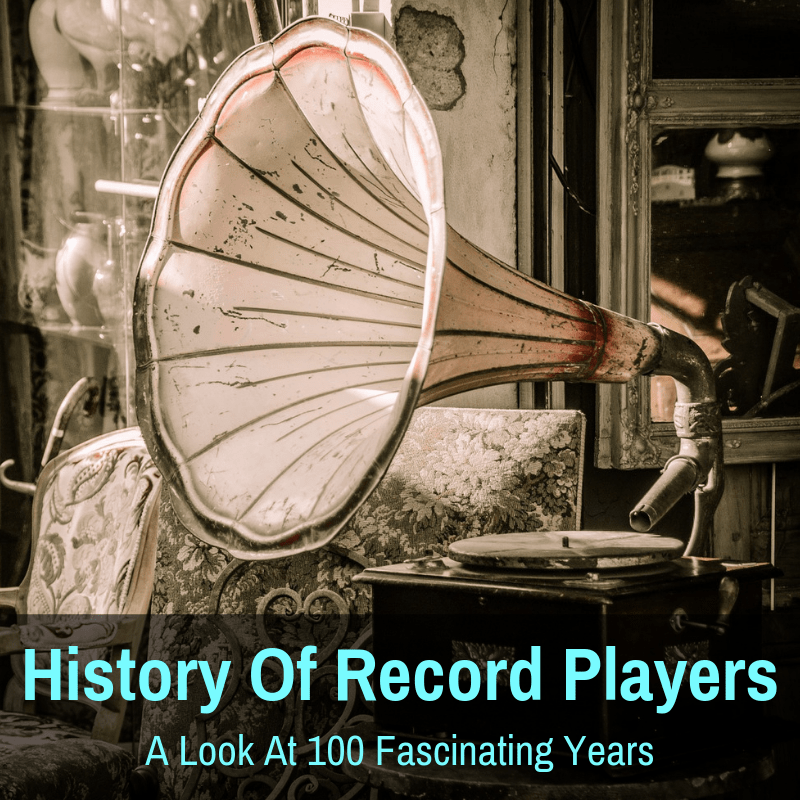
When it was first introduced, it changed music history.
It allowed us to listen to a musical piece in the comfort of our own home.
Instead of having to go out and see musicians live, something we could do only occasionally, we could suddenly listen to music far more often.
It changed our whole relationship with music and it is no surprise that the history of record players is inextricably linked with the history of music.
Let’s take a look at that history, from the very first devices that could record and play music, to modern turntables with all of their features.
Contents
- 1 A History Of The Record Player
- 1.1 When Was The Record Player Invented?
- 1.2 Who Invented The First Record Player?
- 1.3 Emile Berliner And The Gramophone
- 1.4 An Improved Design
- 1.5 Mass Production
- 1.6 The Rise Of The Record Player
- 1.7 The Hip Hop Scene
- 1.8 The Return Of The Turntable
- 1.9 How Vinyl Records Came To Be
- 1.10 The Modern Turntable
- 2 Record Player History: Related Questions
- 3 Turntable History: Final Thoughts
A History Of The Record Player
The history of record players begins with its invention and the man who seemingly invented everything.
When Was The Record Player Invented?
According to the history books, the record player was invented in 1877. Actually, it was a phonograph, and not a turntable, but it is considered the first record player. It was in 1887 that the gramophone was invented, which became the basis for the modern record player.
Who Invented The First Record Player?
Thomas Edison invented the phonograph in 1877. This innovative device both played and recorded sound with the use of a tinfoil covered cardboard cylinder for playback.
Later on, Alexander Graham Bell added wax to the design, which would record waves of sound. This change in the design later resulted in the graphophone.
Emile Berliner And The Gramophone
Emile Berliner called his invention the gramophone, which he patented in 1887. This invention consisted of shellac and hard rubber. Later on, it would be made with vinyl.
This invention was later considered the basis of the record player we know and love. It was able to interpret grooves on flat discs instead of the cylinder that Edison used. At this point, the vinyl record became necessary.
An Improved Design
Emile Berliner’s major breakthroughs, the turntable, was mechanized and designed to spin the record with the help of a direct drive system or belt. As the record spins, a needle reads the grooves.
This needle is cone-shaped and hangs from a stretchy band of metal. The turntable needle is usually made out of a hard material, such as a diamond or sapphire.
The needle is set at one end of the tonearm which is located on the side of the turntable, parallel to the vinyl. The arm moves across the vinyl as the needle follows the grooves.
The needle picks up the vibrations as it moves around the grooves of sound and these vibrations travel through the metal band located at the end of the arm and to the wires of the cartridge at the end of the tonearm.
The coil, which is in a magnetic field, turns the vibrations into an electric signal which is then carried from the wires to the amp. These signals eventually turn into sound via the speakers, producing the music. For more detail, check out my article on how record players work.
Mass Production
In 1895, the first record player was mass produced. It was incredibly popular until the introduction of radio.
While the introduction of radio didn’t exactly make the record player obsolete, it did take away the spotlight for a period of several years. In the 1930s and the 1940s, turntables sold well, but they didn’t really become mainstream until approximately twenty years later.
The Rise Of The Record Player
In the 1960s and the 1970s, the turntable was back on the map with the release of the first model that provided stereo playback. This type of Hi-Fi sound hit the scene and caused thousands of people to purchase a turntable of their own. The automatic turntable was also a big hit in the 1960s.
The Hip Hop Scene
In the 1980s and 1990s, hip hop DJs found a new way to use turntables by connecting audio mixers and using their hands to scratch the vinyl against the stylus in order to produce a totally new sound.
While some people use record players to play music at home, many DJs still use them with mixers to add a new layer of sound to their sets.
The Return Of The Turntable
After several years of CDs and digital music, hardcore audiophiles have brought vinyl back. Now, vinyl is once again being sold everywhere, including popular retail chains and your local music store. There are even new innovations, like the vertical record player.
Additionally, many big artists are now releasing their albums on vinyl, complete with beautiful cover work and free digital downloads with the purchase.
How Vinyl Records Came To Be
Vinyl records replaced the rubber discs produced by Berliner. These records were much easier to mass produce and their master copies could easily be copied by using lacquer on the cutting machine.
A record’s master copy will send the electrical signals to the cutting machine via a cutting head. The cutting head is what holds the needle and cuts the grooves into the lacquer that is wrapped around the middle of a disc.
The lacquer is sent to a company where it’s then covered in metal to make the final master copy. Basically, the master copy is a type of negative for a record that can be used each time the record is mass produced.
The metal copy of the record is used to make a stamper which is put onto a hydraulic press placed with vinyl between the plates. Steam is used to soften the vinyl, then it’s stamped and cooled using water, in order to finish the record.
The Modern Turntable
The recent boost in vinyl sales resulted in the need for bigger and better record players. Many casual music listeners and audiophiles continue to want to experience their music on records while also wanting a more modern touch and better functionality in their record players.
These features include Bluetooth connectivity, USB recording, speed options, aux and RCA connections, and more.
These days, reproductions of vintage models have become the next big thing. They look like vintage models on the outside, but have all the modern features on the inside.
Some of the best record players have built-in speakers, which make it possible to just plug in the unit and start listening to records, without the need to purchase an external preamp and additional speakers.
They also have modern features, like the ability to skip tracks, for instance. We have an article on how to skip songs on vinyl that covers this.
Many of the newer turntables models are priced much more affordably compared to the first models that were produced over one hundred and forty years ago.
These days, it’s totally possible to purchase a good quality model for under three hundred dollars. That is a major change considering that back when the gramophone was invented, only wealthy families were able to afford one for their home.
Record Player History: Related Questions
Are Vinyl Records Worth It?
If you’re considering buying a turntable, but you’re not sure if that nostalgic sound of vinyl is really worth the steep price tag that comes with this hobby, there are a few things to consider that can help you to determine whether vinyl is the right option for you.
First, it is an expensive hobby. Even if you don’t have to purchase an amp or speakers, the cost of a turntable, combined with some standard upgrades can really hit your wallet hard.
The cost of vinyl alone can run anywhere from one dollar into the thousands, if you decide to become a serious collector. In the course of a year, you can easily end up spending hundreds of dollars to build your vinyl collection.
But if you’re serious about building your collection, the hunt for that rare record can be just as exciting as finally finding and purchasing it.
Basically, collecting vinyl can be fun and rewarding, and vinyl does in fact offer the type of unique sound that you won’t get from a digital file, which tends to sound too clean to many audiophiles.
In the beginning, you really don’t have to invest hundreds of dollars in a vinyl collection or a new turntable. Start off small, learn where to find the best turntable deals, and grow your collection gradually, over time.
Do Record Players With Built-In Speakers Sound Good?
Sound quality will vary from model to model and will depend on the quality and size of the speakers themselves. If you’re looking for a solid record player complete with built-in speakers and an impressive dynamic range, I recommend the 1byone High-Fidelity Turntable with Built in Speakers.
Does the Color of the Vinyl Impact the Sound Quality?
This is a question that has been debated for decades. But we now know that the color of vinyl can impact sound quality.
A record player can track colored vinyl much differently than your basic black vinyl. There have been some reports that colored records tend to skip much more frequently than black vinyl. Some listeners also claim that the music sounds a little different on colored vinyl as well.
However, the grooves in the records are exactly the same, so this may have to do more with the type of cartridge and record player that’s used. In terms of surface noise, basic black vinyl is considered the quietest. Red, green, blue or even glow in the dark records tend to be much louder.
If you’re considering buying colored vinyl, I recommend giving it a shot and deciding on your own how color can impact volume, sound quality, and the overall listening experience.
Turntable History: Final Thoughts
The turntable completely changed how we enjoyed music at home. The history of record players is fascinating, since we get to watch them make their long journey from the phonograph to a record player that now allows you to stream your favorite music without a wired connection, listen to the radio, play CD, cassettes, and much more.
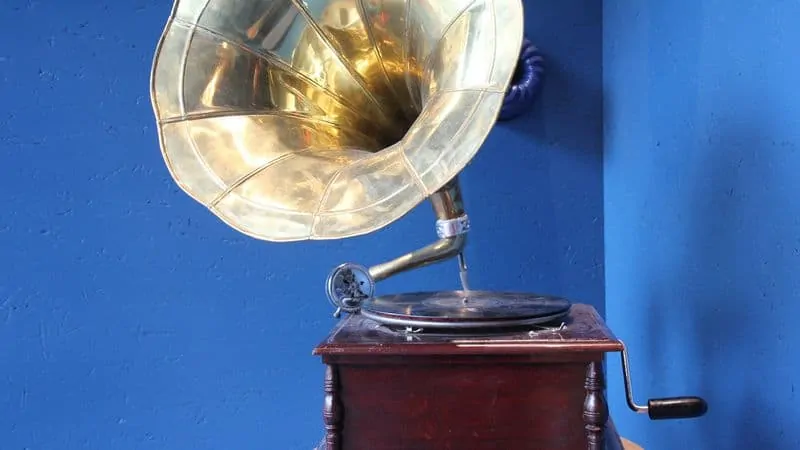
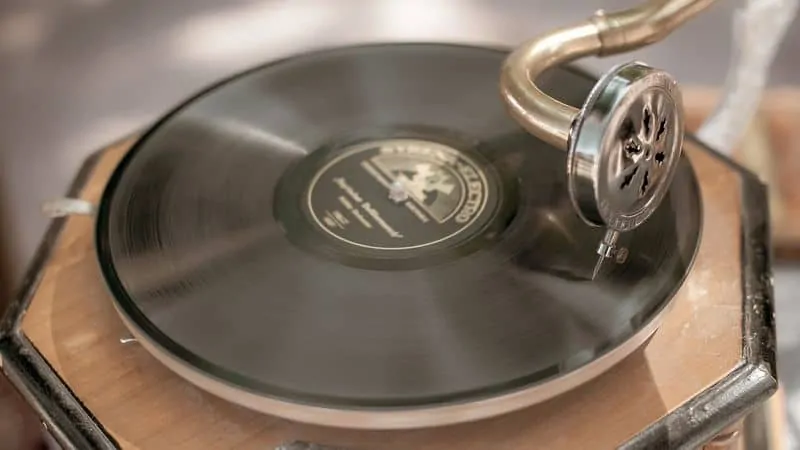
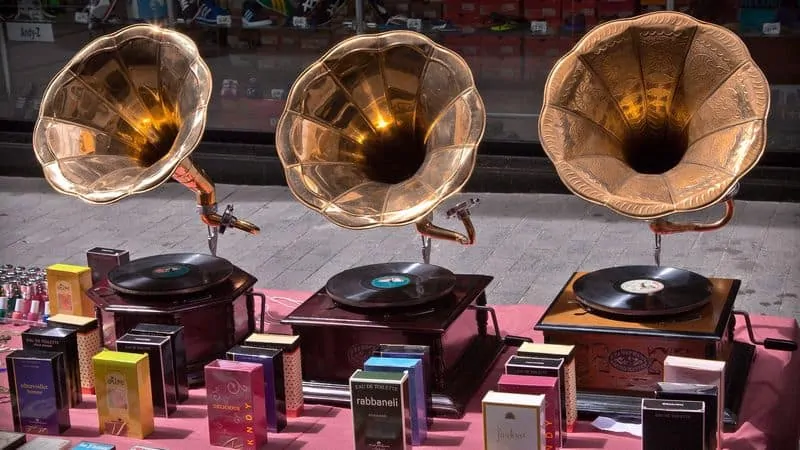
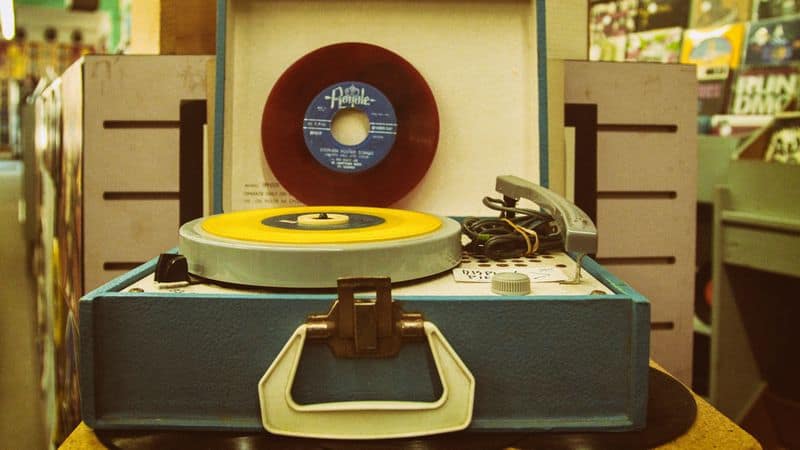
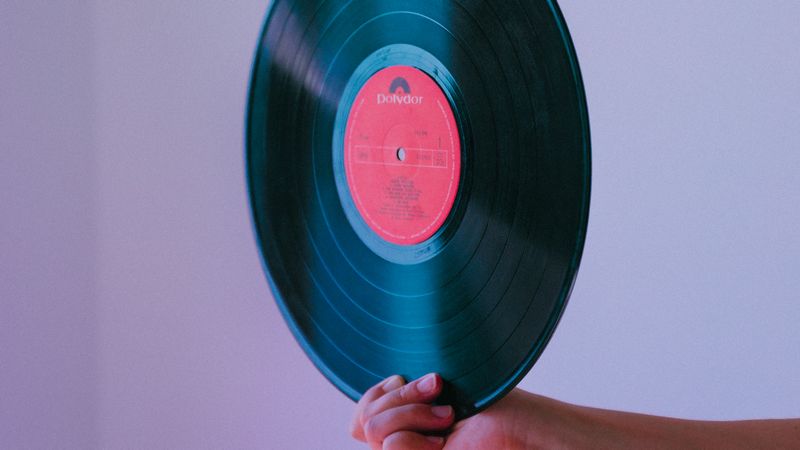
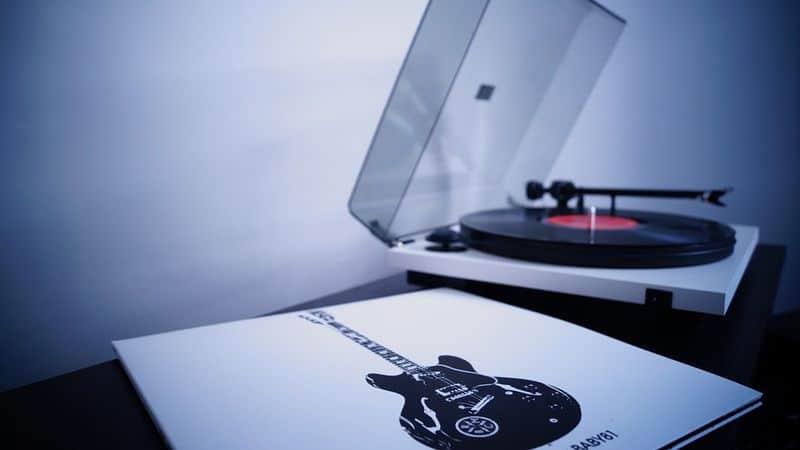
It’s a very nice simplistic view of the beginnings of the Phonograph. However, the photos attached are of replicas. Those of us who collect Victor, Edison, Columbia Graphophone, Gramophones, etc.,, would be more than happy to supply future journalist with authentic visuals.
I completely agree with you. An entire era (1880’s-1920’s) of wax cylinders; both 2 min and 4 min were left out of the article. No mention of the different types of reproducers used for each type of cylinder and corresponding RPM’S for each one. I posses a number of antique high end collector quality Edison, Victor, Columbia, Standard etc. talking machines, cylinder players as well as photos. No purist collector would Ever consider buying a reproduction(like in the pics). There is also no mention of shellac, or the evolution of Edison/Victor/Columbia from cylinders to 78’s. I’m a reseller of anything audio from 1880’s-2000’s, tube to transistor who’s learning about the aforementioned formats to the present. I acquired 100’s of cylinders, 78’s, shellac’s and vinyl (1000’s in total) One thing common on this site is Discogs, I use it, Love it!
Great reply! Wondering about your used equipment sales.
How do I connect?
Thank You!
Lou
There were no cartridges in the 1890’s. Your description of how a gramophone works confuses gramophones and modern turntables. Gramophones used the needle to vibrate a spring within an exponential horn which amplified the sound
I have a callaro England twin turntable record player that is in a suitcase type box making it portable in great condition would you know how much it would be worth approx thanks brian
You skipped right over the several models of record players of the late 1930s and the 1940s which would broadcast to their home radio receivers. They were quite popular in their day
Wow! This blog post is so interesting! I had no idea that record players had been around for so long!
I recently visited the Johnson Victrola Museum in Delaware. Curious that there is no mention of Eldrige Johnson. Based on the museum visit, he has a place in the pantheon of early pioneers of recorded sound and at a critical juncture, a relationship with Berliner, He also sold his global business to RCA which resulted in making RCA Victor a household name.
Hello I don’t have a pic but my buddy showed me a mini travelling victrola,it’s in a box about as big as a camera box it’s no bigger than 10x 10 inches ,I thot he was pulling a small tripod for a camera but to my amazement he put it together and the lid is the needle holder and the tripod turned into the turn table,,it’s nothing I’ve ever seen before ,wondering if you have ,thanks for ur time
Sincerely ckauffman